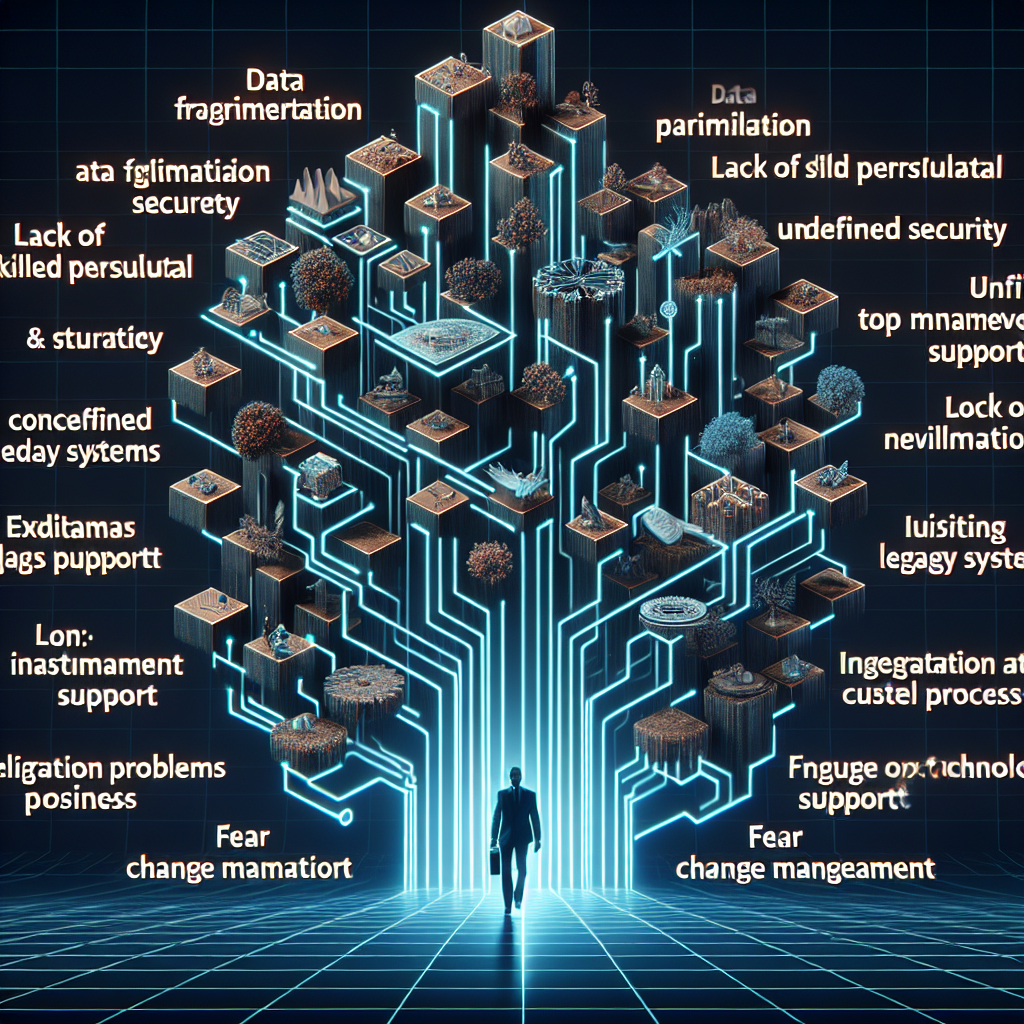Introduction
In the rapidly evolving landscape of technology, Artificial Intelligence (AI) stands out as a transformative force with the potential to revolutionize industries, enhance productivity, and drive innovation. However, despite its promising capabilities, the journey to effective AI adoption is fraught with challenges. Organizations often encounter a myriad of obstacles that can impede the successful integration and utilization of AI technologies. This article delves into the 11 most common barriers to effective AI adoption, offering insights and strategies to overcome these hurdles. By addressing these challenges head-on, businesses can unlock the full potential of AI, ensuring a smoother transition and maximizing the benefits of this groundbreaking technology.
Strategies for Overcoming Data Quality Issues in AI Adoption
Effective AI adoption hinges on the quality of data that feeds into the algorithms. Poor data quality can lead to inaccurate predictions, biased outcomes, and ultimately, a lack of trust in AI systems. To overcome data quality issues, organizations must implement robust strategies that ensure the integrity, accuracy, and relevance of their data. One of the first steps in addressing data quality issues is to establish a comprehensive data governance framework. This framework should outline the policies, procedures, and standards for data management across the organization. By doing so, companies can ensure that data is consistently collected, stored, and processed in a manner that meets predefined quality criteria.
In addition to a strong governance framework, organizations should invest in advanced data cleaning and preprocessing techniques. These techniques involve identifying and rectifying errors, inconsistencies, and missing values in the dataset. For instance, data imputation methods can be used to fill in missing values, while outlier detection algorithms can help identify and correct anomalies. By employing these techniques, organizations can significantly enhance the quality of their data, thereby improving the performance of their AI models.
Moreover, it is crucial to implement continuous monitoring and validation processes to maintain data quality over time. This involves regularly auditing the data to detect any deviations from quality standards and taking corrective actions as needed. Automated tools can be particularly useful in this regard, as they can provide real-time insights into data quality issues and facilitate prompt resolution. Furthermore, organizations should establish clear roles and responsibilities for data quality management, ensuring that there is accountability at every level.
Another critical strategy is to foster a culture of data quality awareness within the organization. This can be achieved through regular training and education programs that emphasize the importance of data quality and its impact on AI outcomes. By raising awareness and building expertise, organizations can empower their employees to take proactive measures in maintaining high data quality standards.
Collaboration with external partners and stakeholders can also play a vital role in enhancing data quality. For example, organizations can work with data providers to ensure that the data they receive meets specific quality criteria. Additionally, engaging with industry consortia and standards bodies can help organizations stay abreast of best practices and emerging trends in data quality management.
Furthermore, leveraging advanced technologies such as machine learning and artificial intelligence can aid in improving data quality. These technologies can be used to develop sophisticated data quality assessment tools that can automatically detect and rectify issues. For instance, machine learning algorithms can be trained to identify patterns and anomalies in the data, enabling organizations to address quality issues more efficiently.
Lastly, it is essential to adopt a holistic approach to data quality management that encompasses the entire data lifecycle. This means considering data quality at every stage, from data collection and storage to processing and analysis. By taking a comprehensive view, organizations can ensure that data quality is maintained throughout the AI adoption process.
In conclusion, overcoming data quality issues is a multifaceted challenge that requires a combination of robust governance frameworks, advanced cleaning techniques, continuous monitoring, and a culture of awareness. By implementing these strategies, organizations can enhance the quality of their data, thereby ensuring the success of their AI initiatives.
Addressing Skill Gaps: Training and Development for AI Implementation

Addressing skill gaps is a critical component in the successful implementation of artificial intelligence (AI) within any organization. As AI technologies continue to evolve and become more integral to business operations, the need for a workforce proficient in these technologies becomes increasingly apparent. One of the primary barriers to effective AI adoption is the lack of adequately trained personnel who can develop, deploy, and maintain AI systems. To overcome this challenge, organizations must invest in comprehensive training and development programs that equip their employees with the necessary skills.
Firstly, it is essential to identify the specific skill sets required for AI implementation. These typically include knowledge in machine learning, data science, programming languages such as Python and R, and an understanding of AI frameworks and tools. By conducting a thorough skills assessment, organizations can pinpoint the gaps in their current workforce and tailor their training programs accordingly. This targeted approach ensures that the training provided is relevant and directly applicable to the tasks at hand.
Moreover, fostering a culture of continuous learning is vital. AI technologies are rapidly advancing, and what is cutting-edge today may become obsolete tomorrow. Encouraging employees to engage in ongoing education and professional development helps keep their skills up-to-date. This can be achieved through various means, such as offering access to online courses, workshops, and seminars. Additionally, partnerships with academic institutions and industry experts can provide valuable insights and training opportunities.
Another effective strategy is to implement mentorship and peer-learning programs. Pairing less experienced employees with seasoned professionals can facilitate knowledge transfer and practical learning. This hands-on approach not only enhances technical skills but also builds confidence in using AI tools and techniques. Furthermore, creating cross-functional teams that include members from different departments can foster a collaborative environment where diverse perspectives contribute to innovative AI solutions.
Investing in specialized training programs is also crucial. These programs should be designed to address the unique needs of different roles within the organization. For instance, data scientists may require advanced training in machine learning algorithms, while IT professionals might need to focus on the integration and maintenance of AI systems. Tailoring training to the specific requirements of each role ensures that all employees are adequately prepared to contribute to AI initiatives.
In addition to technical skills, it is important to develop soft skills that are essential for AI implementation. Critical thinking, problem-solving, and effective communication are key competencies that enable employees to navigate the complexities of AI projects. Training programs should, therefore, include modules that focus on these areas, ensuring a well-rounded skill set.
Furthermore, organizations should consider leveraging external expertise when necessary. Hiring consultants or collaborating with AI vendors can provide access to specialized knowledge and skills that may not be available in-house. This approach can be particularly beneficial during the initial stages of AI adoption, where expert guidance can help avoid common pitfalls and accelerate the learning curve.
Finally, it is important to measure the effectiveness of training programs. Regular assessments and feedback mechanisms can help identify areas for improvement and ensure that the training objectives are being met. By continuously refining their training strategies, organizations can build a robust workforce capable of driving successful AI initiatives.
In conclusion, addressing skill gaps through targeted training and development is essential for overcoming one of the most significant barriers to effective AI adoption. By investing in comprehensive and ongoing education, fostering a culture of continuous learning, and leveraging external expertise, organizations can equip their employees with the skills needed to harness the full potential of AI technologies.
Navigating the regulatory and ethical challenges in AI deployment is a critical aspect of overcoming barriers to effective AI adoption. As organizations increasingly integrate artificial intelligence into their operations, they must address a complex landscape of regulations and ethical considerations. This process begins with understanding the regulatory environment, which varies significantly across different regions and industries. Compliance with these regulations is not merely a legal obligation but also a means to build trust with stakeholders, including customers, employees, and partners.
One of the primary regulatory challenges is data privacy. With AI systems often relying on vast amounts of data, ensuring compliance with data protection laws such as the General Data Protection Regulation (GDPR) in Europe or the California Consumer Privacy Act (CCPA) in the United States is paramount. These regulations mandate stringent controls over data collection, storage, and processing, requiring organizations to implement robust data governance frameworks. Failure to comply can result in severe penalties and damage to an organization’s reputation.
In addition to data privacy, there are concerns about bias and fairness in AI algorithms. AI systems can inadvertently perpetuate or even exacerbate existing biases if not carefully designed and monitored. This ethical challenge necessitates a commitment to transparency and accountability in AI development. Organizations must adopt practices such as regular algorithm audits, diverse training data sets, and inclusive design processes to mitigate bias. By doing so, they can ensure that AI systems operate fairly and equitably, thereby fostering public trust.
Moreover, the issue of explainability in AI is another significant ethical consideration. Many AI models, particularly those based on deep learning, function as “black boxes,” making it difficult to understand how they arrive at specific decisions. This lack of transparency can be problematic, especially in high-stakes areas such as healthcare, finance, and criminal justice. To address this, organizations should prioritize the development of explainable AI models that provide clear and understandable insights into their decision-making processes. This approach not only enhances trust but also facilitates regulatory compliance by demonstrating that AI systems are making decisions based on sound and justifiable criteria.
Furthermore, the deployment of AI raises questions about accountability and liability. When AI systems make decisions that lead to adverse outcomes, determining responsibility can be challenging. Organizations must establish clear governance structures that delineate accountability for AI-related decisions. This includes defining roles and responsibilities, setting up oversight mechanisms, and ensuring that there are processes in place for addressing grievances and rectifying mistakes. By doing so, organizations can navigate the ethical complexities of AI deployment and maintain public confidence.
Another critical aspect is the need for continuous education and training. As AI technologies evolve rapidly, staying abreast of regulatory changes and ethical best practices is essential. Organizations should invest in ongoing training programs for their employees, ensuring that they are well-versed in the latest developments and equipped to handle the associated challenges. This proactive approach not only enhances compliance but also fosters a culture of ethical AI use.
In conclusion, navigating regulatory and ethical challenges is fundamental to overcoming barriers to effective AI adoption. By prioritizing data privacy, addressing bias and fairness, ensuring explainability, establishing accountability, and investing in continuous education, organizations can successfully integrate AI into their operations while maintaining compliance and public trust. This holistic approach not only mitigates risks but also paves the way for the responsible and sustainable deployment of AI technologies.
Q&A
1. **What is a common barrier related to data in AI adoption?**
– Poor data quality and availability.
2. **How can organizations address the skills gap in AI adoption?**
– By investing in training and hiring skilled professionals.
3. **What is a common organizational barrier to AI adoption?**
– Resistance to change and lack of executive support.Overcoming the 11 common barriers to effective AI adoption involves addressing issues such as data quality and availability, talent shortages, integration challenges, lack of clear strategy, cultural resistance, ethical concerns, regulatory compliance, high costs, scalability issues, security risks, and the need for continuous learning and adaptation. By systematically tackling these obstacles through strategic planning, investment in skills and infrastructure, fostering a culture of innovation, and ensuring ethical and regulatory alignment, organizations can successfully harness the transformative potential of AI to drive growth and efficiency.

